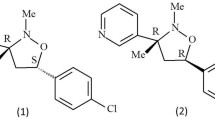Abstract
The fungal plant pathogen, Myrothecium verrucaria, is highly virulent to several important weed species and has potential utility as a bioherbicide. However the production of macrocyclic trichothecene mycotoxins by this fungus presents significant safety concerns. It was discovered that trichothecenes are removed from M. verrucaria spores by repeated washes with water. These washed spores retained bioherbicidal efficacy against kudzu when tested in field trials and on sicklepod when tested under greenhouse conditions. Changes in the growth medium combined with washing spores with water resulted in greater than 95% reduction in roridin A and verrucarin A. Washing spores reduced trichothecene concentrations in spore preparations with no significant effect on plant biomass reduction, thus demonstrating the possibility of M. verrucaria formulations with improved safety to researchers, producers and applicators.


Similar content being viewed by others
References
Abbas HK, Tak H, Boyette CD, Shier WT, Jarvis BB (2001) Macrocyclic trichothecenes are undetectable in kudzu (Pueraria montana) plants treated with a high-producing isolate of Myrothecium verrucaria. Phytochemistry 58:269–276
Abbas HK, Johnson BB, Shier WT, Tak H, Jarvis BB, Boyette CD (2002) Phytotoxicity and mammalian cytotoxicity of macrocyclic trichothecene from Myrothecium verrucaria. Phytochemistry 59:309–313
Anderson KI, Hallett SG (2004) Herbicidal spectrum and activity of Myrothecium verrucaria. Weed Sci 52:623–627
Boyette CD, Walker HL, Abbas HK (2002) Biological control of kudzu (Pueraria lobata) with an isolate of Myrothecium verrucaria. Biocontrol Sci Technol 12:75–82
Boyette CD, Reddy KN, Hoagland RE (2006) Glyphosate and bioherbicide interaction for controlling kudzu (Pueraria lobata), redvine (Brunnichia ovata), and trumpetcreeper (Campsis radicans). Biocontrol Sci Technol 16:1067–1076
Boyette CD, Weaver MA, Hoagland RE, Stetina KC (2008) Submerged culture of a mycelial formulation of a bioherbicidal strain of Myrothecium verrucaria with mitigated mycotoxin production. World J Microbiol Biotechnol 24:2721–2726
Hoagland RE, Boyette CD, Weaver MA, Abbas HK (2007) Bioherbicides: research and risks. Toxin Rev 16:1–30
Hoagland RE, Weaver MA, Boyette CD (2008) Enzyme-linked immunosorbent assay detection of trichothecenes produced by the bioherbicide Myrothecium verrucaria in cell cultures, extracts, and plant tissues. Commun Soil Sci Plant Anal 39:3059–3075
Hoagland RE, McCallister TS, Boyette CD, Weaver MA, Beecham RV (2011) Effects of Myrothecium verrucaria on morning-glory (Ipomoea) species. Allelopath J 27:151–162
Jarvis BB, Pavanasasivam G, Bean GA (1985) Mycotoxin production from Myrothecium species. In: Lacey J (ed) Trichothecenes and Other Mycotoxins. J. Wiley, New York, pp 221–231
Millhollon RW, Berner DK, Paxson LK, Jarvis BB, Bean GW (2003) Myrothecium verrucaria for control of annual morningglories in sugarcane. Weed Technol 17:276–283
Saxton AM (1998) In: Proceedings SAS users group inter Conf., 23rd, SAS institute, Carey, NC, USA. A macro for converting mean separation output to letter groupings in proc mixed. pp 1243–1246
Steele RGD, Torrey JH, Dickeys DA (1997) Multiple comparisons Principles and procedures of statistics - a biometrical approach. McGraw Hill, New York
Vogel HJ (1956) A convenient growth medium for Neurospora. Medium N. Microbiol Genet Bull 13:42–43
Walker HL, Tilley AM (1997) Evaluation of an isolate of Myrothecium verrucaria from sicklepod (Senna obtusifolia) as a potential mycoherbicide agent. Biol Control 10:104–112
Weaver MA, Lyn ME (2007) Compatibility of a biological control agent with herbicides for control of invasive plant species. Nat Area J 27:264–268
Weaver MA, Jin X, Hoagland RE, Boyette CD (2009a) Improved bioherbicidal efficacy by Myrothecium verrucaria via spray adjuvants or herbicide mixtures. Biol Control 50:150–156
Weaver MA, Hoagland RE, Boyette CD, Zablotowicz RM (2009b) Macrocyclic trichothecene production and sporulation by a biological control strain of Myrothecium verrucaria is regulated by cultural conditions. World Mycotoxin J 2:35–43
Yang S-m, Jong SC (1995) Factors influencing pathogenicity of Myrothecium verrucaria isolated from Euphorbia esula on species of Euphorbia plant disease. Plant dis 79:998–1002
Author information
Authors and Affiliations
Corresponding author
Rights and permissions
About this article
Cite this article
Weaver, M.A., Boyette, C.D. & Hoagland, R.E. Bioherbicidal activity from washed spores of Myrothecium verrucaria . World J Microbiol Biotechnol 28, 1941–1946 (2012). https://doi.org/10.1007/s11274-011-0996-8
Received:
Accepted:
Published:
Issue Date:
DOI: https://doi.org/10.1007/s11274-011-0996-8




